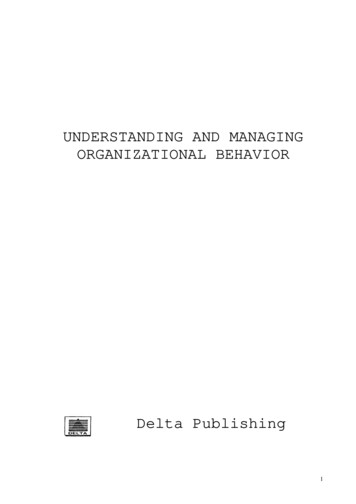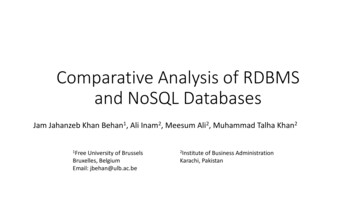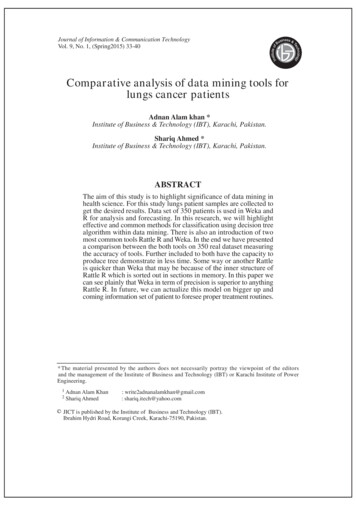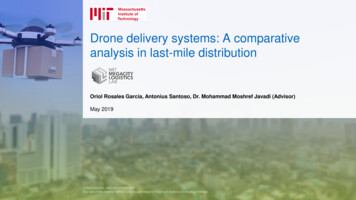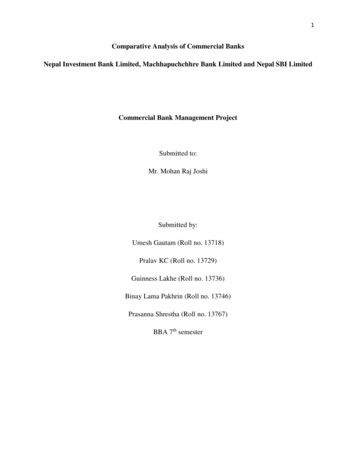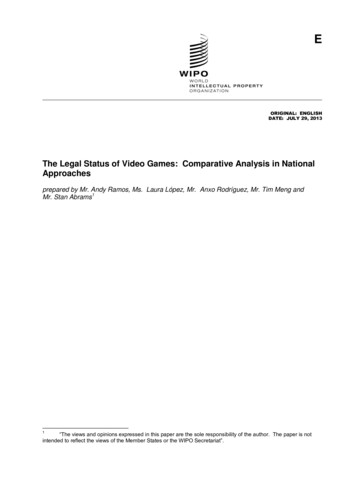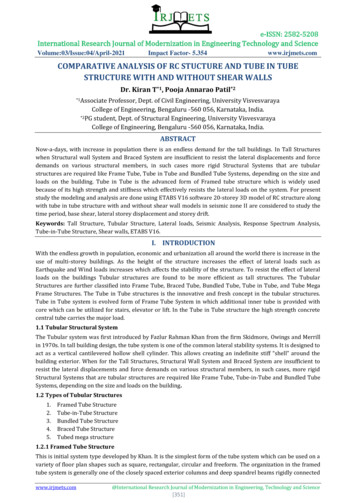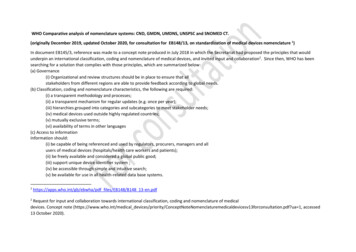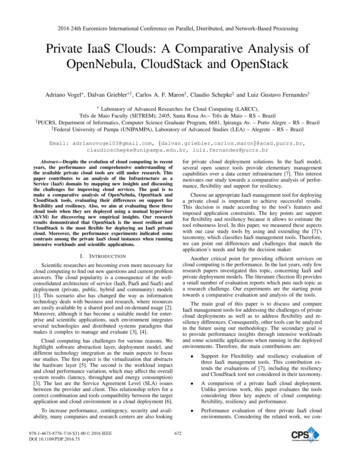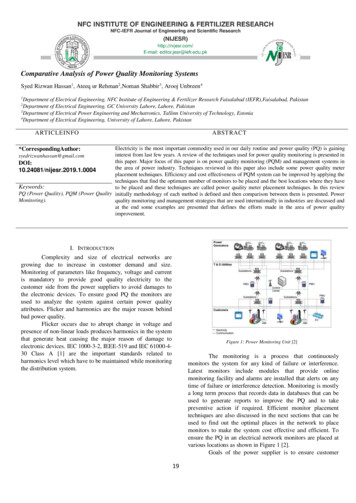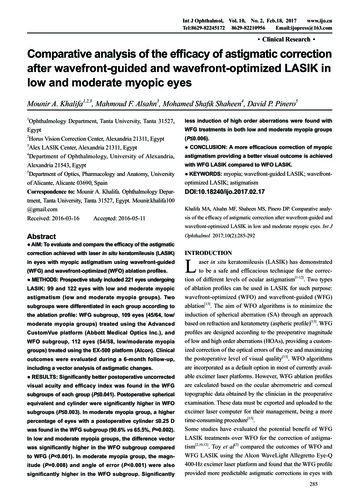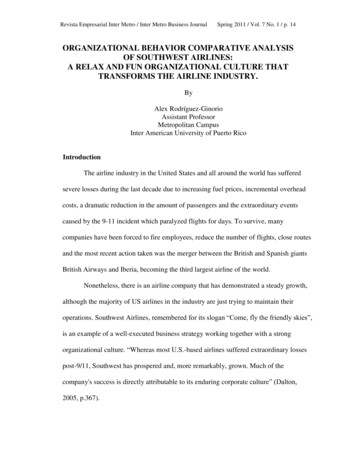
Transcription
Revista Empresarial Inter Metro / Inter Metro Business JournalSpring 2011 / Vol. 7 No. 1 / p. 14ORGANIZATIONAL BEHAVIOR COMPARATIVE ANALYSISOF SOUTHWEST AIRLINES:A RELAX AND FUN ORGANIZATIONAL CULTURE THATTRANSFORMS THE AIRLINE INDUSTRY.ByAlex Rodríguez-GinorioAssistant ProfessorMetropolitan CampusInter American University of Puerto RicoIntroductionThe airline industry in the United States and all around the world has sufferedsevere losses during the last decade due to increasing fuel prices, incremental overheadcosts, a dramatic reduction in the amount of passengers and the extraordinary eventscaused by the 9-11 incident which paralyzed flights for days. To survive, manycompanies have been forced to fire employees, reduce the number of flights, close routesand the most recent action taken was the merger between the British and Spanish giantsBritish Airways and Iberia, becoming the third largest airline of the world.Nonetheless, there is an airline company that has demonstrated a steady growth,although the majority of US airlines in the industry are just trying to maintain theiroperations. Southwest Airlines, remembered for its slogan “Come, fly the friendly skies”,is an example of a well-executed business strategy working together with a strongorganizational culture. “Whereas most U.S.-based airlines suffered extraordinary lossespost-9/11, Southwest has prospered and, more remarkably, grown. Much of thecompany's success is directly attributable to its enduring corporate culture” (Dalton,2005, p.367).
Revista Empresarial Inter Metro / Inter Metro Business JournalSpring 2011 / Vol. 7 No. 1 / p. 15Southwest Airlines is not just a recent success story. “Probably the mostsignificant development in the U.S. airline industry during the past decade has been thecontinued expansion of Southwest Airlines and the resurgence of low-fare entrygenerally” (Transportation Research Board, 1999 as cited by Boguslaski, Ito, & Lee,2004, p. 317). The company has a long and positive track record. “Since its first flight in1971, Southwest Airlines (SWA) has captured new passenger traffic through timely andprudent entry into markets where full-service carriers have historically accounted for amajority of the flights” (Tierney & Kuby, 2008, p.16). While the major airlines likeAmerican Airlines and Delta hub in the largest and most busy airports, Southwest createda strong base offering accessible rates to commuters flying non-stop from or to smallerairports. “SWA has found a way around this problem by using airports on the urbanfringe of the metropolitan centers it does not serve” (Tierney & Kuby, 2008, p.16). Thisstrategy helped Southwest Airlines develop, giving the strength necessary to compete andeven surpass major competitors.Table 1Southwest Airlines AccomplishmentsYearAwardSponsor2004 Top Performing CompaniesAviation Week and Space Technology2004 Performance Through PeopleThe Forum for People Performance andMeasurement (2005)2003 America's Top Ten AdmiredCompanies Fortune2003 Airline of the Year AirTransport Magazine2003 Corporate Conscience Award for CommunitySocial AccountabilityInternational Positive Impact2003 Brand Keys Customer Loyalty AwardBrandweek2003 Most Pleasant AirlineBabycenter.com2003 Best Domestic Airline of the YearTravel Weekly2003 World's Most Socially Responsible CompaniesGlobal Finance Magazine2003 Employer of Choice Among College StudentsFortune2002-2003 100 Best Corporate Citizens BusinessEthics Magazine2002-2003 Best Reputation among U.S. airlinesHarris Interactive Inc. and the ReputationInstitute2002-2003 Airline of the Year Air CouriersConference of America2002-2003 Top 20 Companies for LeadersChief Executive Magazine2001-2004 The 50 Most Desirable MBA EmployersFortune2001-2003 Best Low Cost AirlineOfficial Airline Guide2000-2003 Hispanic Corporate 100HISPANIC Magazine
Revista Empresarial Inter Metro / Inter Metro Business JournalSpring 2011 / Vol. 7 No. 1 / p. 161997-2003 Most Admired Airline in the WorldFortune1972-2002 Best Performing Stock over the Thirty-yearMoney Magazine period from 1972-2002--------------Source: Southwest Airlines fact sheet cognitions (Southwest Airlines, 2004). Adaptation from Jeanquart, S. M., & Glynn, W. M. (2005). Positioningsouthwest airlines through employee branding. Business Horizons 48(1), p. 536.An organizational behavior comparative analysis was performed in order toillustrate how Southwest Airlines’ strategies and organizational culture compares withthose of other airlines. The analysis from the search findings will discuss the followingorganizational concepts: a) leadership, b) organizational culture, and c) selection andhiring procedures. Other organizational elements will also be mentioned and a conclusioncomparing the performance of several airlines.A great part of Southwest Airlines’ success can be awarded to its low-fare, ontime and point-to-point strategy. Nevertheless, what makes Southwest Airlines differentfrom the competition and a consistent winner is its charismatic and creative leadership, afun and people (customers and employees) oriented positive organizational culture, and aselective job process based on values and the desire for excellent service.LeadershipSouthwest Airlines’ co-founders and subsequent leaders did not just establish andadminister an airline; they created a new traveling experience for the passengers and theiremployees. “More than 38 years ago, Rollin King and Herb Kelleher got together anddecided to start a different kind of airline” (Southwest.com, 2009). According toSouthwest.com (2009) from the beginning the purpose of King and Kelleher was to offerpassengers the lowest possible fares, on-time schedules and a good time during all thetraveling planning, buying, flying, and getting to the desire destination process “Thesource of Southwest’s caring and fun-loving culture is Herb Kelleher ” (Robbins &Judge, 2009, p. 552). King and Kelleher innovate and use their creativity to penetrate a
Revista Empresarial Inter Metro / Inter Metro Business JournalSpring 2011 / Vol. 7 No. 1 / p. 17complicated and an already competitive industry. Tubbs and Jablokow (2009), indicatethe results of a recent survey performed by Business Week in association with the BostonConsulting Group, which ranked Southwest Airlines among the world’s twenty-five mostcreative companies.In contrast, Arnoult (2001) describes Skip Barnette, a thirty year Delta veteran incharge of another commuter called Atlantic Southwest Airlines, as a more traditional andcautious leader. Barnette’s vision was to become the best regional airline, basically byimproving the customer service. Although, improving customer service is a must in todaybusiness, his major barrier was to inspire confidence between the management team(Arnoult, 2001). The problem was that even Atlantic Southwest Airlines executives werenot sure. “Watts agrees, citing Southwest Airlines, known for its cheery employees whospread the gospel of customer service according to charismatic leader HerbKelleher.”Skip is not Herb," says Watts” (Arnoult, 2001, p. 53). Robbins and Judge(2009) include Herb Kelleher (Southwest Airlines) as an example of a contemporaryfounder and leader who has had a significant impact on their organizational culture.Organizational CultureS. Chakraborty and D. Chakraborty (2004) indicated “There is a significant Indianproverb relevant to this issue: yatha raja, tatha praja (like leader, like follower)” (p.198).After reading this citation it seems so simple to understand why Southwest Airlines’organizational culture reflects its co-founder values and “servant’s heart” (Robbins &Judge, 2009, p. 552) attitude. “The company s relaxed culture can be traced directly toits CEO and co-founder Herb Kellerher” (Sandri & Lees, 2001, p. 854). Southwestculture is characterizes by its fun and enjoyable organizational environment. Gary Kelly,actual CEO, as cited by Bryant (2007) explains that fun comes as a by-product after
Revista Empresarial Inter Metro / Inter Metro Business JournalSpring 2011 / Vol. 7 No. 1 / p. 18achieving success, working in an enjoyable place, with good people that value theemployee s dedication.While other airlines are focus in the economic issues of the operation, SouthwestAirline’s main concern is how to maintain a formal operation structure that offersflexibility, empowerment and a notion of fun regarding the employees’ workenvironment and customer service. “By placing employees on an equal plane (no punintended) with customers, Southwest Airlines has built a culture that facilitates employeeretention and satisfaction” (Dalton, 2005, p.367). For Southwest Airlines’ employees,their work is not an eight to five job. The organizational culture encourages employees tobe prepared to offer their help at any moment. For examples, pilots will help flightattendance check the passengers and off-duty employees, like a foreman of groundequipment assisted a flight attendant tend a food poisoning passenger and later helped herclaim the baggage (southwest.com, 2009).Southwest Airlines’ organizational culture seems more like a family orientedbusiness, where everybody is part of the family. Peavy (1998) writes, Southwest Airlinesis a different company that focus in “business techniques” and more important, “ onloving its employees, recognizing them and having fun playing games and celebratingsuccess along the way” (p. 162). A working environment, like this, where the employee isconsider as well as the customer will built, in the long run, an emotional bonding and astrong organizational culture. “Over time a dominant set of norms will emerge, guidingthe way in which work is accomplished within the organization” (Sandri & Lees, 2001, p.853).Another of the benefits of Southwest Airlines’ organizational culture is theincremental effect in productivity. The employees work better in a better environment.
Revista Empresarial Inter Metro / Inter Metro Business JournalSpring 2011 / Vol. 7 No. 1 / p. 19“Southwest has significantly higher labor and capital productivity than most of itscompetitors” (Boguslaski, Ito, Lee, 2004, p. 321). Definitely, this feeling of familyorganization is the main competitive advantage that Southwest Airlines have over thecompetitors. To maintain the organizational culture growing it is essential to implementdifferent practices to continue strengthening the message with actual and new employees.“The aforementioned characteristics of a positive culture cannot exist without widespreademployee support” (Sandri & Lees, 2001, p. 854).Organizational PracticesHofstede and Bond (1988) as cited by Abu, Latiff, and Chee (2008) “suggest thatthe power behind the economic rise of the East Asian's economy, which outperforms itsWestern counterparts, has more to do with its cultural practices” (p.339). According toStewart (1998) and Noe et al. (1997) as cited by Milliman, Ferguson, Trickett, andCondemi (1999) Southwest long-term success is consequence of HRM practices designedto create the proper environment that will energize and inspire people willingness tosupport and follow the company’s values and strategy. According to Sandri & Lees,(2001) some of the Southwest Airlines’ organizational practices include a) implementingan informal and fun atmosphere encourage by the CEO, b) recognizing employees’special dates, duties, and personal activities, c) encouraging employees to pitch in whereneeded, and d) a rigorous screening process for the selection of new employees.“Theyhave found that techniques and recognition must work together” (Peavey, 1998, p. 162).Other practices that differentiate Southwest Airlines from the others include a) itswillingness to promotes a free to move philosophy between its employees, b) a workplacespiritually, c) high level of empowerment, d) selective hiring.
Revista Empresarial Inter Metro / Inter Metro Business JournalSpring 2011 / Vol. 7 No. 1 / p. 20Free to Move philosophy“One way to ensure a consistent employee experience is to encourage employeedevelopment and movement within the company” (Bryant, 2007, p. 38). Theorganizational structure is a high formalization one, similar to the other airlines due to theregulations and security measures after 911. Nonetheless, Southwest Airlines strongorganizational culture permits a high degree of flexibility, especially, in matters related toconsumer service. According to Bryan (2007), this strategy builds strong leaders andimproves the retention strategy.Workplace Spiritually“An active spiritual life can help individuals find meaning and purpose in theirlives and live out deeply-held personal values” (Block, 1993& Ray, 1992 as cited byMilliman, Ferguson, Trickett, & Condemi, 1999, p. 221). Employees demonstrate a highlevel of teamwork and a natural desire to serve and act in the best interest of the companyand its consumers. “First, SWA has a strong emphasis on community (Godsey, 1996;Tyler, 1998). “ there is a strong feeling among the employees that they are part of afamily and that the employees take care of each other as well as their customers”(Milliman, Ferguson, Trickett,& Condemi, 1999, p. 221). “Second, SWA employees feelthey are part of a cause. According to Milliman et al. (1999) Southwest Airlines’employees feel that being part of an airline with the lowest airfares, personalize service,and characterized by a humorous environment gives the opportunity to people that couldnot afford it to fly. Freigberg and Freiberg (1996) as cited by Milliman, et al. (1999)wrote “ a sense of being a "rebel," independence, and liberty are associated withSWA's cause or mission of offering low-cost, fun air travel” (p. 221).
Revista Empresarial Inter Metro / Inter Metro Business JournalSpring 2011 / Vol. 7 No. 1 / p. 21Servant’s HeartFollow The Golden RuleAdhere to the Basic PrinciplesTreat others with respectPut others firstBe egalitarianDemonstrate proactive Customer S
A great part of Southwest Airlines’ success can be awarded to its low-fare, on-time and point-to-point strategy. Nevertheless, what makes Southwest Airlines different from the competition and a consistent winner is its charismatic and creative leadership, a fun and people (customers and employees) oriented positive organizational culture, and aFile Size: 293KBPage Count: 15
